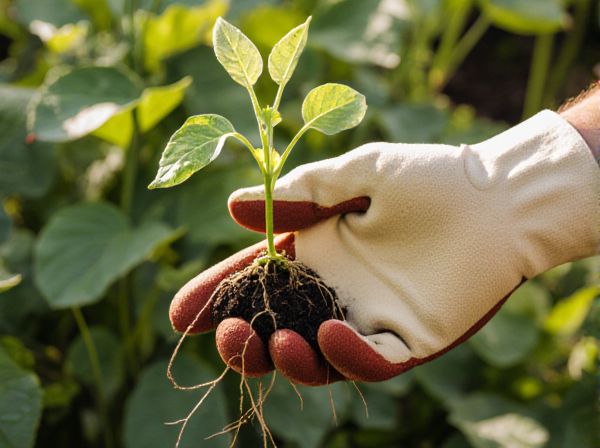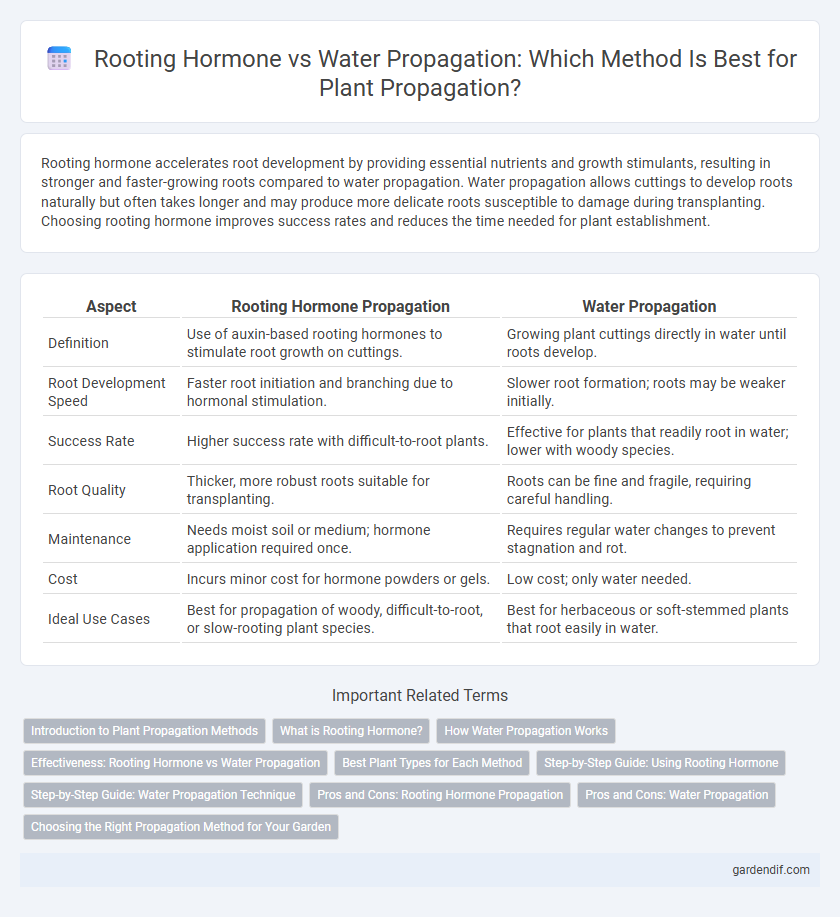
Rooting Hormone vs Water Propagation Illustration
Rooting hormone accelerates root development by providing essential nutrients and growth stimulants, resulting in stronger and faster-growing roots compared to water propagation. Water propagation allows cuttings to develop roots naturally but often takes longer and may produce more delicate roots susceptible to damage during transplanting. Choosing rooting hormone improves success rates and reduces the time needed for plant establishment.
Table of Comparison
| Aspect | Rooting Hormone Propagation | Water Propagation |
|---|---|---|
| Definition | Use of auxin-based rooting hormones to stimulate root growth on cuttings. | Growing plant cuttings directly in water until roots develop. |
| Root Development Speed | Faster root initiation and branching due to hormonal stimulation. | Slower root formation; roots may be weaker initially. |
| Success Rate | Higher success rate with difficult-to-root plants. | Effective for plants that readily root in water; lower with woody species. |
| Root Quality | Thicker, more robust roots suitable for transplanting. | Roots can be fine and fragile, requiring careful handling. |
| Maintenance | Needs moist soil or medium; hormone application required once. | Requires regular water changes to prevent stagnation and rot. |
| Cost | Incurs minor cost for hormone powders or gels. | Low cost; only water needed. |
| Ideal Use Cases | Best for propagation of woody, difficult-to-root, or slow-rooting plant species. | Best for herbaceous or soft-stemmed plants that root easily in water. |
Introduction to Plant Propagation Methods
Rooting hormone accelerates plant propagation by inducing root development through concentrated auxins, enhancing success rates compared to water propagation, which relies on natural rooting processes in a hydration medium. Water propagation offers simplicity and visual monitoring of root growth but lacks the hormonal stimulus critical for faster, more reliable root formation. Selecting a propagation method depends on plant species, desired propagation speed, and resource availability, with rooting hormones favored for challenging cuttings and water propagation suited for easier-to-root plants.
What is Rooting Hormone?
Rooting hormone is a substance containing plant growth regulators, primarily auxins, that stimulate root development in plant cuttings. It enhances cell division and elongation at the cutting's base, leading to faster and more reliable root formation compared to water propagation. This hormone improves the success rate of propagation by accelerating root initiation and increasing the robustness of new roots.
How Water Propagation Works
Water propagation works by immersing plant cuttings in water to stimulate root development through moisture absorption and oxygen availability. The process encourages cells at the cutting's base to differentiate into root tissues while maintaining hydration and preventing desiccation. This method is effective for many herbaceous and semi-woody plants, promoting faster root initiation compared to traditional soil propagation.
Effectiveness: Rooting Hormone vs Water Propagation
Rooting hormone significantly accelerates root development and improves success rates compared to water propagation, especially for hardwood and semi-hardwood cuttings. Water propagation is effective for soft-stemmed plants but often results in weaker root systems and slower growth. Studies show rooting hormones can increase root formation effectiveness by up to 70%, making them a preferred choice for consistent propagation outcomes.
Best Plant Types for Each Method
Rooting hormone is most effective for woody plants such as roses, fruit trees, and shrubs, where it stimulates faster root development in cuttings. Water propagation works well for herbaceous plants like pothos, philodendrons, and herbs, allowing easy monitoring of root growth in a transparent environment. Selecting the right method enhances successful propagation based on plant tissue type and rooting requirements.
Step-by-Step Guide: Using Rooting Hormone
Apply rooting hormone powder or gel to the base of a healthy cutting to stimulate root growth and improve success rates. Dip the cutting's cut end into the hormone, shaking off excess, then plant it in a sterile rooting medium such as perlite or vermiculite to ensure optimal moisture retention and aeration. Keep the propagated cutting in a humid environment with indirect light, maintaining consistent moisture until roots develop in 1-3 weeks.
Step-by-Step Guide: Water Propagation Technique
Fill a clear container with filtered water and submerge the cut end of the plant stem just below the surface to promote root development using oxygen-rich water. Replace the water every 2-3 days to prevent bacterial growth and maintain optimal conditions for root formation. Once roots reach at least 2-3 inches in length, transplant the cutting into soil to ensure successful establishment and continued growth.
Pros and Cons: Rooting Hormone Propagation
Rooting hormone propagation accelerates root development by stimulating cell growth and increasing the success rate for many plant species. This method reduces the risk of fungal infections and enhances nutrient absorption compared to water propagation. However, improper application can cause hormone toxicity, and some plants may be sensitive, requiring precise concentrations for optimal results.
Pros and Cons: Water Propagation
Water propagation offers clear visibility of root development, allowing early detection of healthy or problematic growth patterns. It provides a sterile environment that reduces soil-borne diseases but may result in weaker root systems compared to soil. Excess water exposure risks oxygen deprivation to roots, increasing the chance of rot if not properly managed.
Choosing the Right Propagation Method for Your Garden
Selecting between rooting hormone and water propagation depends on plant species and desired success rate. Rooting hormone accelerates root development by promoting cell growth, making it ideal for woody cuttings and plants with slower rooting processes. Water propagation suits soft-stemmed plants and allows easy monitoring of root growth but may increase the risk of rot in some species.
Rooting Hormone vs Water Propagation Infographic

 gardendif.com
gardendif.com